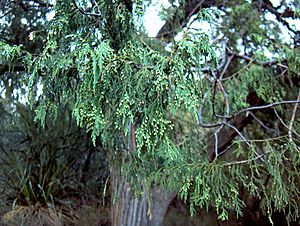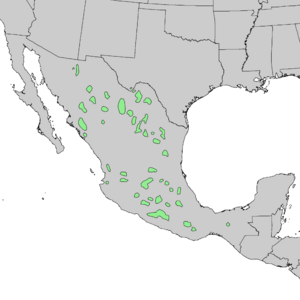Drooping juniper facts for kids
Quick facts for kids Drooping juniper |
|
|---|---|
 |
|
| J. flaccida in Big Bend National Park | |
| Conservation status | |
| Scientific classification | |
| Genus: |
Juniperus
|
| Species: |
flaccida
|
 |
|
| Natural range of Juniperus flaccida | |
Juniperus flaccida is a type of tree or large bush. People often call it the drooping juniper, weeping juniper, or Mexican juniper. Some Native American names for it include tláscal. This plant can grow quite tall, usually between 5 to 10 meters (about 16 to 33 feet), but sometimes even up to 15 meters (nearly 50 feet).
Contents
About the Drooping Juniper
Where it Grows
The drooping juniper naturally grows in central and northern Mexico. You can find it from the state of Oaxaca all the way northward. It also grows in a small part of the extreme southwest of Texas in the United States, specifically in Brewster County. This plant prefers to grow in dry soils. It is found at medium heights, from about 800 to 2,600 meters (around 2,600 to 8,500 feet) above sea level.
What it Looks Like
The bark of the drooping juniper is brown. It has long, stringy cracks that run up and down the trunk. Its branches hang down strongly, which is why it's called "drooping" or "weeping." These branches are thin, about 1 to 1.2 millimeters wide. They often grow in flat, wide sprays, which is quite unusual for a juniper.
Leaves and Cones
The leaves of the adult plant look like small scales. They are about 2 to 4 millimeters long and 1 to 1.5 millimeters wide. On the main growing tips, they can be a bit longer, up to 7 millimeters. The leaves grow in pairs, with each pair opposite the last. Young plants, called seedlings, have needle-like leaves that are longer, about 5 to 10 millimeters.
The cones of this juniper look like berries. They are round and can be quite large, from 8 to 20 millimeters across. They start out green and turn brown as they get older. Inside each cone, there are many seeds, usually 6 to 12. This is more seeds than in any other type of juniper cone. It takes about 18 months for the cones to fully mature.
The male cones are smaller, about 3 to 5 millimeters long. They release their pollen in the spring. Most drooping juniper trees are either male or female. This means one tree will only produce male cones, and another tree will only produce female cones.
Different Types of Drooping Juniper
Scientists have found that there are a few slightly different types, or varieties, of Juniperus flaccida.
- One type, called Juniperus flaccida var. flaccida, is found across most of the plant's natural range. Its cones are usually 9 to 15 millimeters wide.
- Another type, Juniperus flaccida var. martinezii, is only found in a small area in Jalisco, Mexico. Its cones are smaller, about 6 to 8 millimeters wide.
- A third type, Juniperus flaccida var. poblana, grows in the southern two-thirds of the plant's range. This type has larger cones, from 12 to 20 millimeters wide.
See also
 In Spanish: Enebro para niños
In Spanish: Enebro para niños


